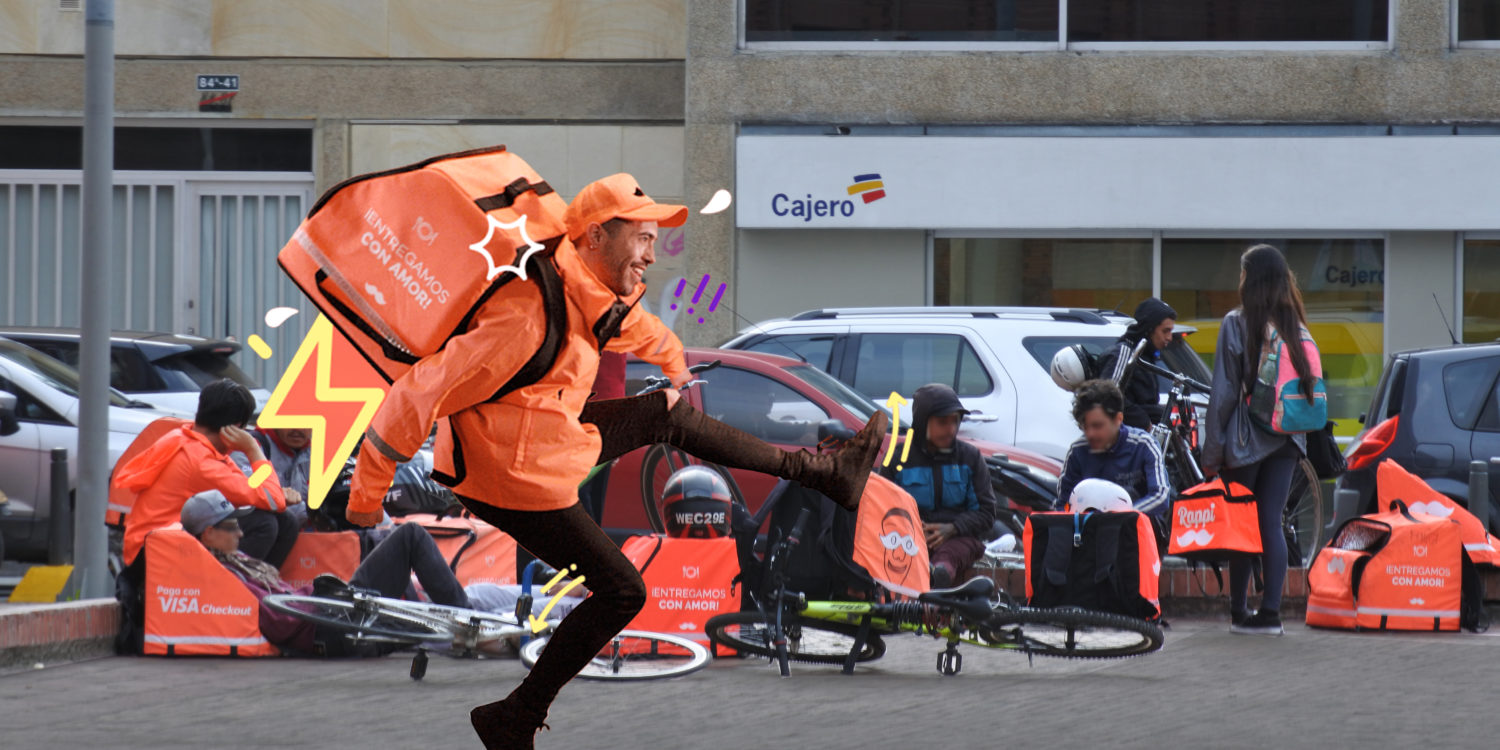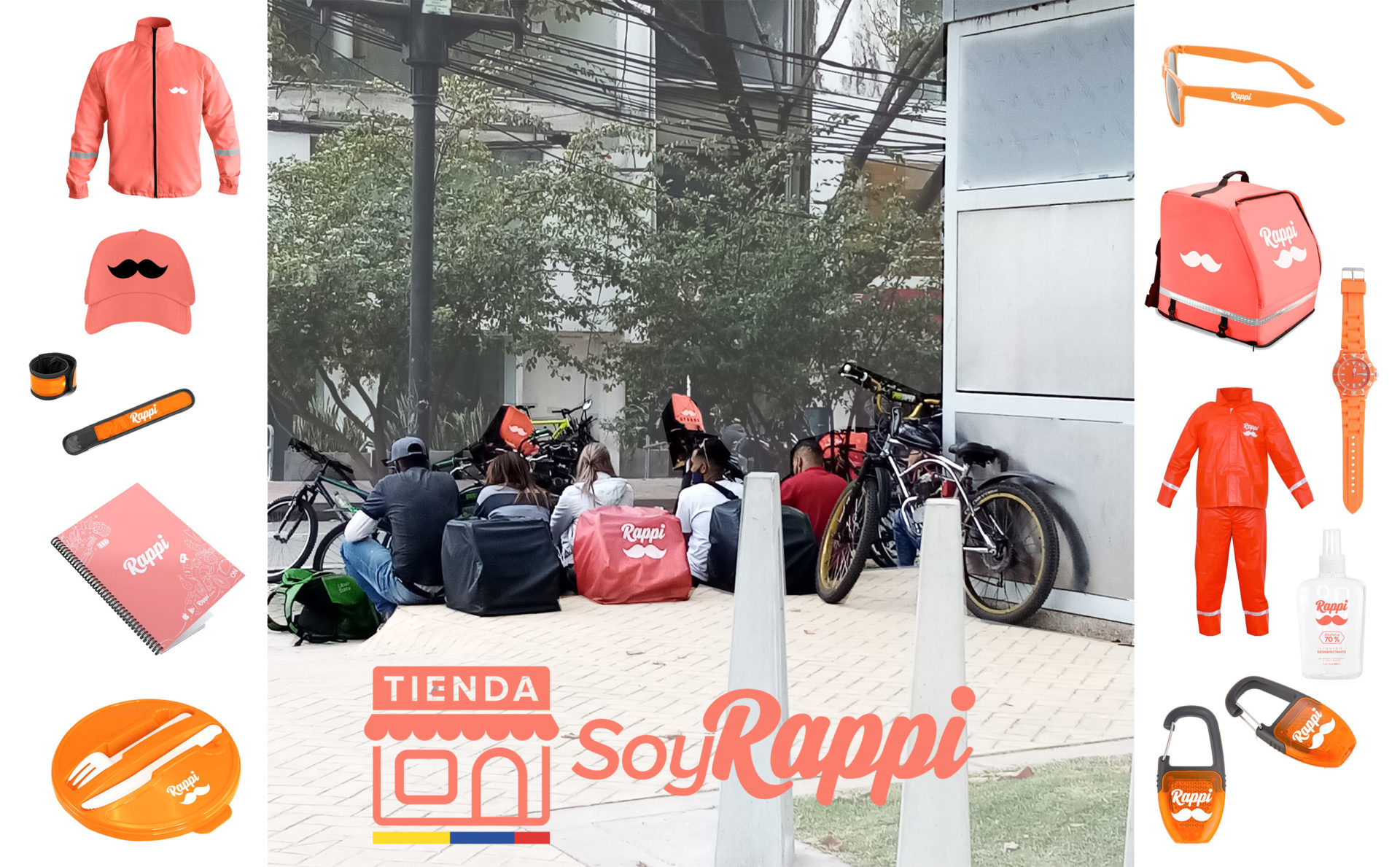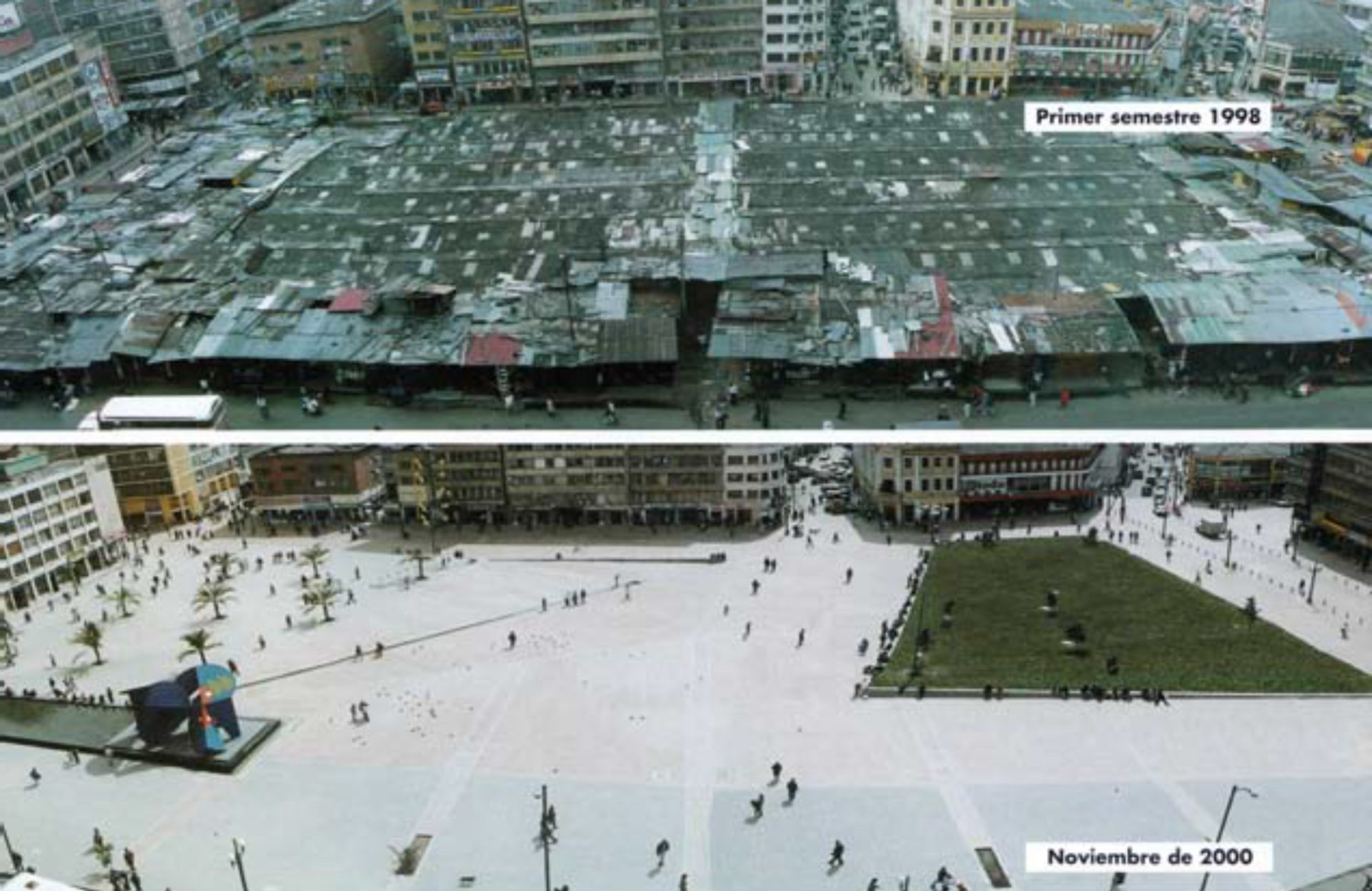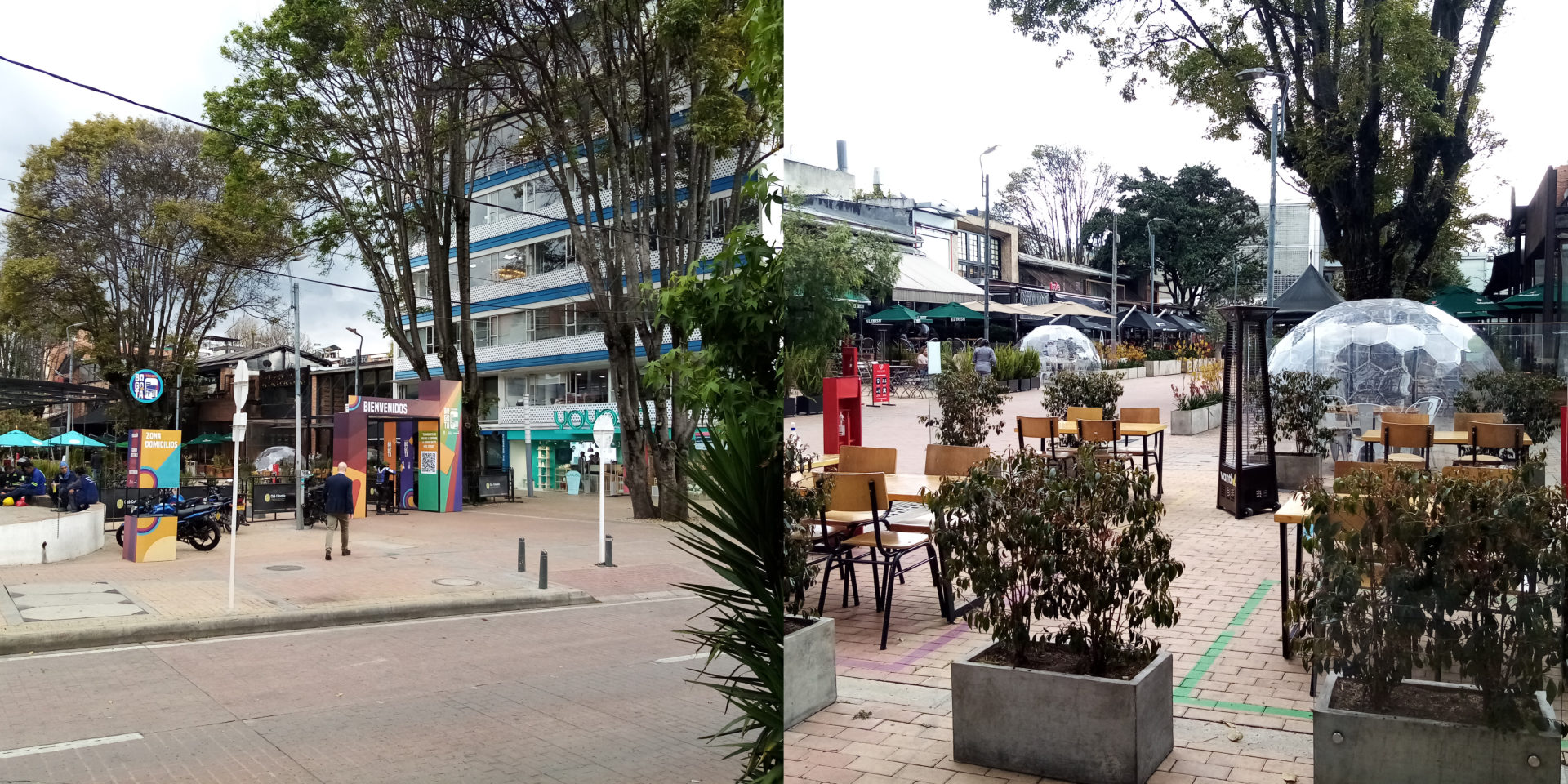Este artículo está disponible en Español.
In November 2020, the residents of an eight-storey apartment complex in the wealthy area of El Retiro in Bogota, the capital of Colombia, drafted a petition to the city mayor asking to “remove or relocate the agglomeration” of delivery workers that used the sidewalk to wait for their next assignment. These workers, called rappitenderos, a friendly moniker that translates to “quick-grocers,” are part of the delivery company Rappi—a digital platform that allows users to dispatch rappitenderos for deliveries and other tasks. The neighbours requested the removal of these workers to “reestablish security and mobility” in the area and to “prevent a focus of contagion amid the sanitary emergency brought by COVID-19.” They also complained that delivery staff occupied the sidewalk to “sit, ingest food, and engage in recreational activities,” parking their bicycles in front of the building, with some even “using the building’s front yard as a public toilet.” The petition linked the increased robberies in the area to these workers, arguing they had “attracted both street vendors and beggars,” and, in doing so, had turned this corner into a “focus of insecurity, noise, and insalubrity.”
This sort of complaint is not uncommon in the city. Since the emergence of Rappi in 2015, the media has often reported on rappitenderos’ “invasion of public space.” The discomfort has increased with COVID, as delivery workers are deemed “essential” to fulfil basic tasks as the government has imposed social distance measures and quarantines. Under these conditions, residents, restaurants, shops, and supermarkets have all come to depend on the services provided by these workers while at the same time rejecting their presence in public spaces.
This same public space is the main venue of Rappi’s plan to bring a “new revolution in logistics.” Delivery apps need workers to circulate through city streets and they rely on sidewalks, parks, and plazas as areas for these workers to remain on standby. However, the company’s reliance on frictionless access to the city’s infrastructure has come up against a deeply entrenched commitment to public space that has developed in Bogota over the past 25 years. City authorities have made public space the backbone of the city’s quest for equality. Laudable though it may sound, this demand for equal access to public space has increasingly been deployed as a protection against “encroaching” and “undesirable” subjects, including delivery workers.

Social media has been a repository for citizens’ complaints in Bogota and other Colombian cities.
Twitter post (left): “What do you think, for example, about rappitenderos appropriation of public spaces?”
Twitter post (right): “Insecurity day and night. Rappi, street vendors, and bicitaxis that invade public space…”
Twitter screenshot
Founded in Colombia, Rappi has become the country’s main delivery app. In the last couple of years, the company quickly expanded after a 1 billion dollar injection by Vision Fund, the controversial venture capital fund run by Softbank. The company is already present in nine Latin American countries including Mexico, Brazil, Argentina, and Chile, promising “to make cities more efficient, to care for the environment, and to improve citizens’ quality of life.” In this pursuit, the app has drastically transformed the landscape of over 100 cities, albeit through a sea of orange rappitenderos flooding the public space rather than anything as concrete as a high-rise office block. These orange dots located across the in-app map of Bogotá position themselves in key spots of cities, always ready to attend their phone and fulfil the company’s motto: “We run for you.”
Rappi has over 400.000 delivery workers in Latin America. The company does not consider them employees. Instead, they use deceptive terms like “independent entrepreneurs.” As with ride-hailing and delivery apps like Uber, Didi, and Ele.me, they contend that this arrangement offers flexibility and self-determination to contracted workers and argue that digital platforms are simply “intermediaries”, thereby avoiding having to provide health insurance or social benefits. Much in a similar way, Rappi has claimed that fulfilling deliveries on their app is not a full-time job but a source of additional income, despite using strategies that covertly force workers to be available at all times. However, a 2019 survey found that this was the only job for more than 80% of these workers in Bogota, to which they devoted 6 to 7 days a week. Several reports have shown the discourse of freedom endorsed by the “gig economy” is fictitious and also linked to deteriorating working conditions and labour standards. Calling these workers “entrepreneurs,” as if they were independently setting up a new business, is a euphemism to conceal the precariousness of the jobs offered by the company.
Even so, delivery apps have become the only possible source of income for thousands of people given the widespread unemployment and high levels of informality in many Latin American cities—a situation that has only worsened with the pandemic. For instance, in Bogota unemployment reached 25% and informality was at 41.9% in 2020. As one of the world’s most unequal regions, Latin America has the ideal conditions for Rappi’s business model to thrive. As one of the company’s founders, Simon Borrero, bluntly put it: “this model works much better in countries with a high Gini.” To state it clearly, the more unequal the country, the easier is for the platform to find an ample supply of needy “entrepreneurs,” willing to submit themselves to its unrewarding policies.
While a full demographic study of rappitenderos hasn’t been made in Colombia, a 2019 survey found that in the case of Bogota, more than half of these workers are young men, under 35 years old, in the lower-income bracket, and 57% of them have migrated from Venezuela (the country has received over 1.7 million Venezuelans in the last decade, the highest in the region). Such is the case of the workers we interviewed while they were waiting for new assignments in El Retiro. One of them told us that they have no standing to complain, especially considering that their Venezuelan origin reduces their work options due to blatant xenophobia. A call from a neighbour rapidly draws the police or the “rappi-brigadistas”—the company’s workforce ensuring delivery workers comply with biosecurity measures. They invariably ask them to “move over and just keep on circulating.” But, needing a place to wait, rest, and eat throughout their workday, they come back. The delivery worker explained: “We are like pigeons—we fly away when they come to scare us off, but a few seconds later when they are gone, we return.”
Arguments in favour of delivery worker removal are rooted in long-standing prejudices. Complaining citizens regard them with suspicion, seeing them as uneducated outsiders with unhealthy habits. The bias is normalised by the profound socio-spatial segregation that splits Bogota into a poorer south and a wealthier north—a division enabled by the “invisible” hand of the market and perpetuated by the national public policy of “socio-economic stratification.” This policy intends to raise equality by making affluent citizens pay more for public services to subsidize those with lesser resources. To do so, cities are sectorised on a scale from 1 to 6 into strata according to the characteristics of their site of residence, from lower to higher affluence. One unintended consequence of this state-sanctioned formula is that the population has come to identify strata with social class, which is also connected to enduring hierarchies based on race and ethnicity. As Rappi’s higher demand areas coincide with the higher strata (4, 5, and 6), delivery workers are seen as, fundamentally, “out of place.”
While fed by this geography of inequality, the discomfort of El Retiro’s neighbours is justified as a morally righteous need to protect the city’s public spaces from “individual interests.” Such justification makes full sense in the context of Bogota, where public space has dominated political discourse since the mid-90s as the essential feature of “civilized” cities. Having witnessed the recuperation of the city’s public spaces, Bogotanos have developed a sense of belonging linked to a normative idea of public space that strongly permeates their imagination and conceptions of the city. In its award of the “Golden Lion” during the 2006 Venice Biennale, for instance, the city’s “revival” was highlighted as a “symbol of hope to other cities, either rich or poor.”
The resignification of public space can be traced back to Enrique Peñalosa’s first term as mayor of Bogota in 1997 in which he proposed to undertake a “grand crusade” to “recover public space.” According to Peñalosa’s diagnosis, Bogota’s public space had been stolen from its citizens by the informal economy, invasive parking, and other “irregular activities”. For him, public space was for encounter and equality. Under this liberal ideology, Peñalosa invited citizens to awake from their “outstanding passivity” and reclaim areas coopted by private hands.
Peñalosa regarded public space as a place to “play, run, seduce, read, and look at other people.” Focusing on pavements, in particular, he argued that they were not just a space of transit but a space to congregate—one where all citizens, no matter their age, class, sex, gender orientation, or race would be equal. However, this obviously ignores the fact that leisure is a privilege not given to everyone equally. During Peñalosa’s term, the “recovery of public space” meant that street vendors couldn’t make their daily living and that homeless people couldn’t make use of it, so as to ensure that others could enjoy the same space without experiencing any obstruction or discomfort.
The discomfort expressed by affluent residents towards delivery workers is inseparable from this history. The presence of these workers disrupts the ideal use of Bogota’s public space as a place of leisure. In this context, the bodies of “other” users become undesirable, even intolerable. Currently, the city prides itself on its recent outdoor dining program and praises restaurants for keeping the city “alive” during the pandemic. In this case, the extension over streets and sidewalks, as well as restrictions on access to them, are not seen as an “invasion” but as a clever “innovation,” up to date with cities such as New York. Instead, rappitenderos’ loitering is framed as a threat that endangers public space and, therefore, in need of regulation by the authorities. What this situation crudely shows is that the comfort of some bodies, mostly wealthy and white citizens, is only possible at the expense of the discomfort of other poor, racialized, and immigrant bodies.
A range of solutions will soon come to “protect” Bogota’s public space from delivery workers. We anticipate such responses will only perpetuate the criminalisation of these workers’ use of public space, and many of them will be embedded in architecture or design. While neighbours will continue to call the police or the company’s brigades, they might also choose, as one of them explained, to “redesign” the areas where workers sit to make it uncomfortable for them to stay (evoking examples of hostile architecture). Rappi could also return to the short-lived initiative of providing small pit-stops across areas of high demand. These stops seem to be even more urgent after Bogota’s mayor, Claudia López, warned the company they should start paying for the use of public space. Or maybe, expanding the ecology of digital platforms selling the solutions to the problems caused by their peers, Heru will arrive to provide all these “independent entrepreneurs” with insurance, credits, and comfortable waiting places for a modest charge, as it already does in Mexico City.
These responses suggest that regulating the presence of delivery workers in public space is a matter of designing colourful and in-fashion pavilions or uncomfortable benches. Yet, design solutions are a diversion. Rappi’s “innovative” idea to solve urban problems such as traffic and commerce through logistics takes advantage of the region’s extreme inequality.

Collage of Rappi’s advertising and Rappitenderos in public space.
CREATIVE COMMONS. Photo by Carlos Felipe Pardo
As an idealised site of smooth equality and enjoyment, public space is always a project in the making. We in Bogota have assumed this project with conviction, despite being constantly faced with a socio-economic reality that defies its fulfilment. In accomplishing this project, street vendors, homeless, and other ‘undesirable’ bodies such as delivery workers that do not use public spaces for leisure and consumption, have often been cast as a menace whose presence requires regulation and, ultimately, expulsion. This discourse is both dangerous and violent. Not only does it ignore the needs of a large segment of the city’s inhabitants but, in the name of protecting and ensuring orderly public spaces, it exposes them to a higher precarity.




